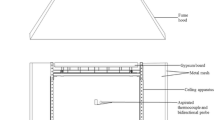Abstract
This paper describes a new algorithm of the Consolidated Fire Growth and Smoke Transport (CFAST) fire model and compares the results with data from real-scale fire tests conducted aboard the ex-USS Shadwell, the U.S. Navy's Research and Development Damage Control Platform. The new phenomenon modeled in this work is the conduction of heat in the vertical direction. The Shadwell tests chosen for validation purposes were part of the Internal Ship Conflagration Control (ISCC) Program. The work focuses on four compartments of the ship that were vertically aligned. The temperatures of the compartments and the decks between them were compared with model predictions. The predictions were very close to the experimental results for all compartments, although the temperatures rise in the topmost compartment was barely above ambient.
Similar content being viewed by others
References
Peacock, R. D., Forney, G. P., Reneke, P., Portier, R., and Jones, W. W., “CFAST, The Consolidated Model of Fire Growth and Smoke Transport,” NISTIR 1299, National Institute of Standards and Technology, 1993.
Williams, F. W., Toomey, T. A., and Carhart, H. W., “The ex-SHADWELL Full-Scale Fire Research and Test Ship,” NRL Memorandum Report 6074 (reissued September 1992), NTIS-ADA198605.
Bailey, J. L. and Tatem, P. A., “Validation of Fire/Smoke Spread Model (CFAST) Using Ex-USS SHADWELL Internal Ship Conflagration Control (ISCC) Fire Tests,” NRL Memorandum Report 6180-95-7781 (September 1995), NTIS-ADA300878.
Jones, W. W. and Forney, G. P., “A Programmer's Reference Manual for CFAST, the Unified Model of Fire Growth and Smoke Transport,” Technical Note 1283, National Institute of Standards and Technology, 1990, 104.
Friedman, R., “International Survey of Computer Models for Fire and Smoke,” Journal of Fire Protection Engineers, Vol. 4 (1992), p. 81.
Golub, G. H. and Ortega, J. M., Scientific Computing and Differential Equations, An Introduction to Numerical Methods, Academic Press, New York, 1989.
Strang, G. and Fix, G. J., An Analysis of the Finite Element Method, Prentice-Hall, Englewood Cliffs, New Jersey, 1973.
Moss, W. F. and Forney, G. P., “Implicitly Coupling Heat Conduction into a Zone Fire Model,” NISTIR 4886, National Institute of Standards and Technology, 1992.
Smith, D. E. and Burns, K. C., “Statistical Support of the Analysis of Full-Scale Fire Tests: The Effect of Wind Conditions,” Technical Report No. 146, Desmatics, Inc., State College, Penn., September 1991.
Kaye, G. W. C. and Laby, T. H., Tables of Physical and Chemical Constants, John Wiley and Sons, New York, 1966.
Jones, W. W. and Peacock, R. D., “Refinement and Experimental Verification of a Model for Fire Growth and Smoke Transport,” Proceedings of the Second International Symposium of Fire Safety Science, Hemisphere Publishing, New York, 1992.
Cooper, L. Y., Harkleroad, H., Quintiere, J., and Rinkinen, W., “An Experimental Study of Upper Hot Layer Stratification in Full-Scale Multiroom Fire Scenarios,” Journal of Heat Transfer, Vol. 104 (November 1982), pp. 741–749.
Author information
Authors and Affiliations
Rights and permissions
About this article
Cite this article
Bailey, J.L., Jones, W.W., Tatem, P.A. et al. Development of an Algorithm to Predict Vertical Heat Transfer Through Ceiling/Floor Conduction. Fire Technology 34, 139–155 (1998). https://doi.org/10.1023/A:1015377402737
Issue Date:
DOI: https://doi.org/10.1023/A:1015377402737




